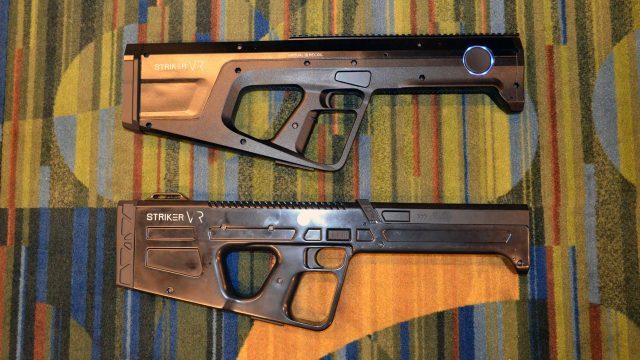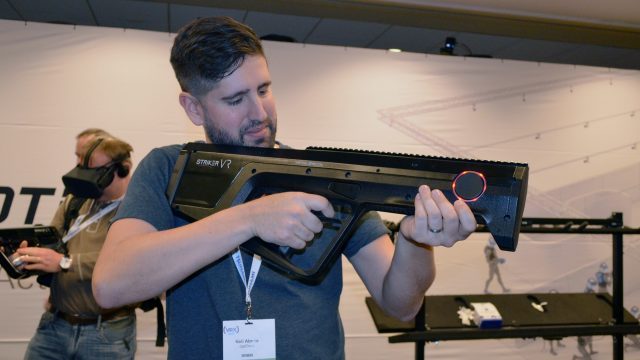Striker VR is developing a haptic gun peripheral for out-of-home VR attractions, which has the most powerful and responsive recoil that I’ve ever tested. The company’s latest prototype, a verification model as the company nears its first manufacturing run, brings a host of improvements.
Striker VR’s ‘Arena Infinity‘ VR gun peripheral uses an electric haptic system to create a powerful and responsive kick that really pushes back against your shoulder and moves the gun when you pull the trigger. In addition to single-fire recoil, the system can also handle burst fire, automatic fire, and a range of programmable haptic effects like a chainsaw, a ‘charge up’ effect for sci-fi weaponry, and more. The gun is tracked with integrated OptiTrack IR LED markers, or with any tracking system that can be mounted to the gun. This video from earlier this year explores how it works.


Last year we got our first look at the Arena Infinity design; the company worked with concept designer Edon Guraziu to settle on a retro-futuristic look and feel for the peripheral. Having battle tested the initial take on that design over the course of the last year, the company’s latest prototype brings improvements to ergonomics and usability while maturing the overall look and feel of the VR gun.


I got to see the company’s latest prototype, fresh out of the engineering lab, at VRX 2017 this week in San Francisco. The first thing I noticed was that the new prototype has a more ergonomic handle, and the geometry around the grip has been modified for better usability. The second thing I noticed, as I pulled the trigger, is that the new prototype is practically silent compared to its predecessor. While the prior prototype made a loud “clack” “clack” with every trigger pull, the new prototype is substantially muffled without losing any of the kick. That’s helpful because it means the real-world audio won’t conflict with the VR game audio, allowing the game creators to decide what the weapon should sound like through software.
Striker VR co-founder Martin Holly told me that he had to turn down the recoil power on the newest prototype because the pre-production plastics are likely to break at full power. Once the final plastics are in place, Holly says the company plans to see just how high they can crank the recoil. I advised that the kick was already plenty powerful for the majority of users!
The latest Arena Infinity prototype also adds a standard Picatinny (sight) rail running along its top edge, which not only serves the thematic purposes of the gun, but also functions as a convenient mounting point for third-party tracking devices like the Vive Tracker. The prototype also has two large trackpads conveniently located at the foregrip of the gun, allowing both right and left-handed users easy access to whatever functions game developers decide to program. For instance, the trackpad could be used to facilitate more traditional input like menu selections, weapon adjustments, and more. I found that my thumb naturally rested right near the trackpad, making it easy to use. Like the prior prototype, this one also has a ‘bump’ button underneath the grip for reloading, and a button above the trigger (on both sides) for switching weapon modes.
There’s also usability improvements for the VR attraction operators who will make use of these peripherals; in addition to a significantly simplified battery, which is easier to charge and swap, Striker VR is developing a software suite which allows operators to monitor and configure all of their Arena Infinity peripherals. The software can also be used to program the guns with new haptic effects.
Co-founder Martin Holly says that there’s still a few changes to come, but the company is soon embarking on their first production batch which will see some 500 weapons delivered to initial VR attraction customers in early 2018.
At $2,800 a pop, it’s still going to be some time before you see a consumer-facing product from Striker VR. However, Holly says the company still has ambitions for the consumer market and is in discussions with HTC who has agreed to help Striker VR experiment with consumer-facing approaches, which would likely involve the company’s Vive Tracker in some way.
Holly revealed to Road to VR that Striker VR raised a $1.5 million angel investment last year. As the company nears its first production batch, he says they also intend to adapt their technology for the military sector and what he called the “custom” sector—selling the company’s haptic feedback component directly to businesses who want to use it outside of the context of a haptic VR gun.

